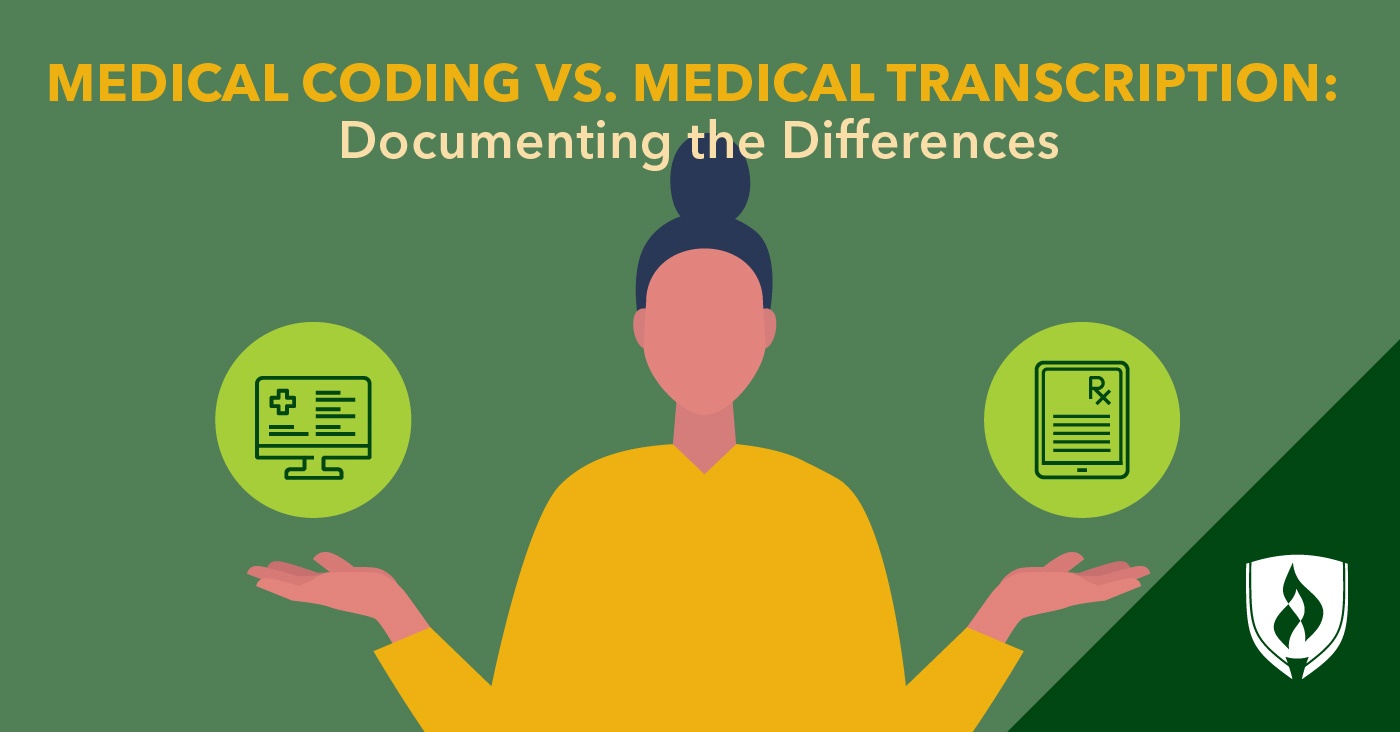Medical Coding vs. Medical Transcription: Documenting the Differences
By Ashley Brooks on 05/10/2021

Healthcare careers often have seemingly similar job titles for roles that are actually quite different—which can make things complicated when you’re trying to narrow down your career options.
Take medical coding versus medical transcription, for example. You have a vague idea that both of these roles involve working behind the scenes in healthcare facilities and knowing particular medical vocabulary. Beyond that, you’re stumped.
How do medical coding and medical transcription roles differ? Do they require a similar amount of education? Most importantly, which one is the better career choice for you?
We’re breaking down the job descriptions of these similar-sounding healthcare careers. Join us as we take a closer look into the roles and responsibilities of medical coders versus medical transcriptionists.
What does a medical coder do?
Medical coding refers to the process of billing insurance companies using a set of industry-standard codes. It would be nearly impossible for healthcare facilities to be properly reimbursed if they relied on insurance providers who are untrained in the medical field to read and understand a physician’s notes.
The medical coding system simplifies—and standardizes—things by assigning a code to each type of medical visit or procedure. It’s a medical coder’s job to translate everyday language and medical jargon from a patient’s visit into the corresponding codes.
In a way, this is similar to learning another language. Medical coders must be familiar with the sets of letters and numbers that make up billing codes so they can communicate billing information to insurance companies as accurately and efficiently as possible.
What does a medical transcriptionist do?
Medical transcriptionists take dictation from physicians and other medical professionals to create written reports, such as patient charts or medical histories.
Sometimes they may join a physician on patient visits to take notes with diagnoses and treatment plans for the patients. Other times, they take a physician’s shorthand notes and translate them into a longer form that nonmedical professionals would be able to understand, or they review transcriptions from dictation software to ensure accuracy.
Like medical coders, transcriptionists must be familiar with a wide array of medical language. Unlike medical coding, however, transcription work is unrelated to billing. Instead, their reports are used to create patients’ electronic health records (EHR) and discharge summaries that are shared with other healthcare workers and, often, patients themselves.
Medical coding vs. medical transcription: Skills needed
Medical coders and transcriptionists have different tasks that serve different audiences, but it’s fair to say that they require similar skills on the job. Both coders and transcriptionists need to be organized, detail oriented and accurate in their work. A mistake in either coding or transcription can lead to larger problems down the road, like incorrect billing statements or inaccurate medical histories.
Medical transcriptionists also need strong active-listening skills. When writing up instructions or notes for patient use, they may not be able to capture every word a physician says. This means they’ll have to use good judgment and listening skills when choosing what to include in their reports.
Medical coders, on the other hand, require a few more technical skills. They need to be familiar with different coding systems, such as ICD-10 and CPT. They must also keep up with changes in coding systems and billing procedures as healthcare technology continues to evolve.
Medical coding vs. medical transcription: Work environment
Medical coders work in a variety of healthcare settings, from expected environments, like hospitals and clinics, to more surprising workplaces, like educational institutions. Medical coders are also needed to work for legal and insurance firms to verify claims and help ferret out incidences of fraud.
You may be surprised to learn that many medical transcriptionists don’t work directly for healthcare facilities. The Bureau of Labor Statistics (BLS) reports that 37 percent of medical transcriptionists work for administrative services agencies who provide transcription and other admin support to healthcare providers.1 The remaining transcriptionists work for hospitals and physicians’ offices, with a small minority being self-employed.1
Medical coding vs. medical transcription: Job outlook
If you’re still stumped about which career may be a better option for you, learning more about their job outlook may sway your opinion.
Medical coders are enjoying a positive job outlook, thanks to the aging baby boomer population that continues to require more healthcare services. The BLS projects an eight percent growth in medical coding jobs from 2019 to 2029, for an estimated addition of 29,000 jobs.1
In contrast, the BLS reports medical transcriptionist jobs aren’t experiencing the fast growth rate of medical coding careers. Due to improvements in automated dictation software, transcriptionist jobs are projected to decline by two percent through 2029, for a loss of 1,300 jobs nationally.1
Medical coding vs. medical transcription: Education needed
Both these healthcare careers require some specialized knowledge of medical terminology, so it’s no surprise that you’ll have to undergo the right training to enter either of these roles.
Medical coders technically don’t have to meet any standard requirements, but the BLS reports most employers are looking for employees with a postsecondary Certificate, and others will want an Associate’s degree.1,2 These education programs will equip you with a foundational knowledge of medical terms and coding systems.
Medical transcriptionists can typically get started by completing a one-year certificate program or earning an Associate’s degree in medical transcription. Like medical coding programs, this training gives you the medical knowledge you need to get started, as well as an understanding of the legal concerns surrounding medical transcription.
Though not required, both careers offer the option to pursue certification from a professional organization—the AAPC or the American Health Information Management Association (AHIMA) for medical coders and the Association for Healthcare Documentation Integrity (AHDI) for medical transcriptionists.
Follow the paper trail to your healthcare career
Now you know all the subtle differences to be aware of when deciding between medical coding versus medical transcription. Keep this information in mind as you decide which of these medical documentation careers could be right for you!
If you’ve weighed your options and medical coding is the healthcare career that’s coming out on top, learn more about how to get started with our article “Your 5-Step Guide to Become a Medical Coder.” and "Where Have all the Medical Transaction Jobs Gone?"
1Bureau of Labor Statistics, Occupational Outlook Handbook, [accessed April, 2021] https://www.bls.gov/ooh/healthcare/medical-records-and-health-information-technicians.htm Information represents national, averaged data for the occupations listed and includes workers at all levels of education and experience. Employment conditions in your area may vary.
2Most coding positions are not considered "entry level"; a combination of education and work experience is typically required to attain a coding position. Similarly, coders, especially those who are new to the field, should not expect to find a position where they can work from home. Most coding positions require onsite work.




